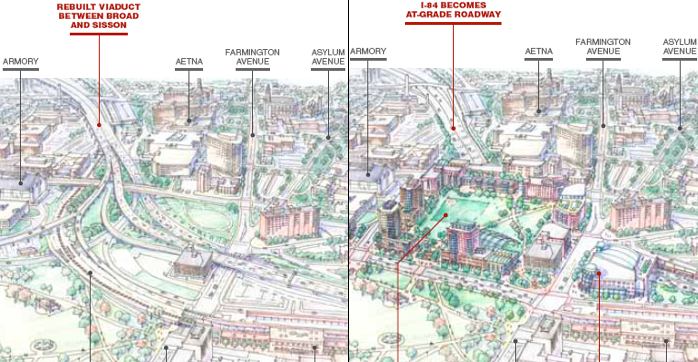
Hartford faces a once-in-a-century opportunity to reshape its downtown as state engineers again turn their attention to the aging “Aetna viaduct” which carries I-84 through the city center. Bringing this elevated highway down offers a chance to reconnect neighborhoods and give the city a major economic jolt.
The viaduct, constructed in 1965, accommodates roughly 175,000 vehicles a day, but it also acts as a barrier between neighborhoods and is a blighting influence around major employers like Aetna and city landmarks like Union Station, Bushnell Park and Capitol Hill. So last decade, when the Connecticut Department of Transportation (CTDOT) began studying a project to replace the now-deteriorating structures, civic and community leaders saw an opportunity to undo some of the disruption caused by the placement of the highway.
Three years ago, the Capitol Region Council of Governments (guided by the aforementioned civic and community leaders, who dubbed themselves the “Hub of Hartford” committee) completed a study of visionary alternatives for I-84. The study found that moving the highway at-grade, placing it in a short tunnel segment between Broad Street and Union Station, and rerouting the Amtrak rail line to the north of I-84 would free up 15-20 acres of developable land next to Union Station. Such a rearrangement could support at least one million square feet of mixed-use development and raise city property taxes by at least $12 million annually. On top of that, new streets and parkland would create a better urban fabric, all while costing the same as rebuilding the viaducts, though far more study is needed to be sure.
ConnDOT has acknowledged the work that’s been done, writing on the project website that “CTDOT previously considered replacing the I-84 viaducts ‘in-kind.’ However, after further study, community input and consultation, CTDOT recognizes that there are great opportunities that might be realized with further assessment of this corridor.”
More visionary solutions might also be easier to fund. The project is estimated at a minimum of $1-2 billion, whether the viaducts are simply replaced as is, or more creative solutions are found. But projects that generate an economic return could be partially financed through federal loan programs like Transportation Infrastructure Finance and Innovation Act (TIFIA) or ideas like value capture that help repay up-front costs with land value increases that accompany infrastructure investments. ConnDOT is also smartly exploring whether tolls or congestion pricing could help fund the massive project.

[…] Repairing the Heart of Hartford | Mobilizing the Region. […]